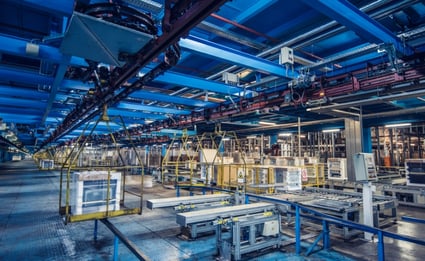The Intersection of Production and Distribution Logistics
Brian Hoey - May 30, 2019

Let’s say that you run a pizza delivery joint. As orders come in by phone or through your website, you have one employee who’s in charge of giving delivery estimates and getting the pizzas to the relevant doorsteps, and another who’s in charge of running back and forth between the storeroom and the kitchen to make sure that the chefs have everything they need to actually make the pizzas. If any of the ingredients in the storeroom get too low, that employee calls the relevant suppliers and arranges to receive and store the delivery. One day, you get a bright idea: what if the delivery person and the employee in charge of restocking the storeroom had direct visibility into one another’s processes?
You decide to give the storeroom manager access to the online delivery ordering system, and the delivery manager gets a key to the storeroom so that he can better understand the pizza supply chain as it’s unfolding. All of a sudden, it’s easier to schedule inbound deliveries proactively, because the storeroom manager has more insight into the demand levels for various toppings. At the same time, the delivery manager can provide more accurate time estimates based on the levels and locations of the toppings being ordered. Maybe he even thinks to offer discounts on certain toppings within the online ordering system based on how quickly or slowly things are moving. This way, your business has fewer ingredient shortages, fewer late deliveries, and more satisfied customers.
Congratulations, you've just successfully integrated production logistics and distribution logistics.
Production Logistics
Production logistics, for those who might need a refresher course, refers to the process of ensuring that each station in a production line has the raw materials and other resources it needs, when it needs them, in order to create products in an industrial context. For our pizza parlor example, this is the equivalent of the storeroom manager, whose job it was to make sure the chefs had the necessary ingredients on hand to fulfill orders as they came in. Within the context of modern, digital supply chain management, production logistics might be the bridge between supply chain management and production management, meaning that it performs an important role in facilitating the creation of value.
If a workflow like production logistics becomes siloized, manufacturers run the risk of operational disconnect between sourcing and production. Your production logistics managers might know what materials need to be where, but if that knowledge isn’t shared with the teams in charge of sourcing and actual production plan, you run the risk of production slowdowns and disruptions. This begs the questions: how can this process be optimally integrated with others up and downstream in the supply chain. As a representative example, we’ll be taking a look at some potential areas of synergy with distribution logistics.
Distribution Logistics
In a way, distribution logistics is the reverse of production logistics. The latter manages material coming in, and the former deals with the way finished goods make their way off of the factory floor and into trucks, and then on to warehouses, distribution centers, and possibly retail stores or customers. Like production logistics, distribution logistics can present some roadblocks if it becomes siloed off from other key processes. On a basic level, you might wind up with transportation plans that don’t reflect recent changes in production ratios, or vice-versa, leading to confusion and disruption. If, for instance, a given distribution plan depends on bundling a particular set of goods into FTLs (full truck loads) to create a smarter distribution web further downstream, production planners need to be aware that efficient transport management will depend on their ability to produce a particular set of goods. This might mean prioritizing this plan over building to incoming orders.
Crucially, since production logistics requires insight into production plans themselves (which should be informed by distribution plans), these two functions stand to benefit from mutually increased visibility and connectivity. Just like in our pizza parlor, production and distribution logistics can work in tandem to add value and reduce costs. How? For starters, by extending the potential benefits of any optimization attempts or increases in efficiency up or downstream, depending. A radical new plan for distribution can be supported by sourcing flows tailored to its success, just as an innovation in the way that production plans are supplied and empowered could be further supported transport flows that account for these changes.
Total Logistics Costs
We’ve seen the ways in which production and distribution logistics can and do intersect, and we’ve given a couple of examples of the ways in which they can interact synergistically. Now we get to the heart of the matter—how can these areas of synergy help to reduce your total logistics costs? After all, on some level that’s the measure of any new paradigm in logistics. Let’s think back to our pizza parlor one last time: the new synergy between delivery management and supply management led to improved accuracy for delivery estimates and more proactive sourcing. In an industrial context (just as much as in the restaurant business), this could easily be translated into more repeat business, as well as more cost-efficient management of raw materials, both of which can have a meaningful impact on the bottom line.
Ultimately, this is just one example—there are plenty of others. The point here isn’t to suggest a specific quick fix for your supply chain management flows, but rather to demonstrate a principle about visibility in the value stream. Many or even most of the various processes that go into the sourcing, production, and distribution of goods intersect somewhere along the line, and those points of intersection offer significant opportunities for optimization. While siloized processes often feel like a fact of life, if you can take steps to increase visibility and break down planning silos, it’s possible to create a production environment in which plans make sense from both a holistic and a granular perspective. In this way, you can pave the way for smoother supply chain management and more effective business processes overall.
If you want to learn more, download your guide to Transformation of Manufacturing Processes.
In this Guide you will learn:
-
Emerging Challenges in the Modern Truck/Automotive Industry
-
How Can Global Companies Adapt to These New Realities
-
How Decentralized Digital Systems Power Smarter Planning Processes
-
How flexis Can Support Flexible Supply Chain Transformation
LATEST POSTS
- Understand Circular Economy in The Manufacturing Industry
- How Can Industry 4.0 IT Integration Be Achieved Smoothly?
- The Significance of Order Sequencing in Discrete Manufacturing
- How to improve your Supply Chain Management: The Power of Control Towers
- Optimizing Human Resource Scheduling in Manufacturing: A Technological Approach



